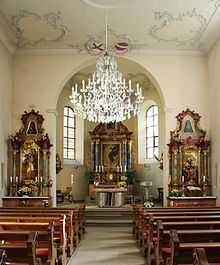Franz Anton Vogel
Franz Anton Vogel (born December 5, 1720 in Wessobrunn in Upper Bavaria , † June 18, 1777 in Freiburg im Breisgau ) was a plasterer of the Wessobrunn school , the most important plasterer in Breisgau in the 18th century. His style was the Rococo .
Life
The parents were the plasterer Georg Vogel (also called Johann Georg Vogel; 1687–1759) and his wife Catharina born. Carpenter. In 1747 Franz Anton asked Freiburg im Breisgau to be accepted as a citizen and guild , because he "intends to heyrate and has now been honest and well behaved for years and days". He may have worked for the older Freiburg plasterer Franz Joseph Vogel (1684–1756), who also belongs to the Wessobrunn school, but to whom he was not related; In 1721 Franz Joseph stuccoed the nave ceiling of the Catholic parish church of St. Gallus and Otmar in Ehaben and around 1725–1730 the ceiling of the current Old Catholic Church of St. Ursula in Freiburg . In 1749 Franz Anton was accepted into the "Zum Mond" guild.
plant
His work includes stucco work
- 1748–1749 in the stairwell built by Johann Caspar Bagnato in the Superiorats building, the parsonage Todtmoos , which today serves as the parsonage.
- around 1750 on the balustrades of the aforementioned St. Ursula Church in Freiburg.
- 1751 in the old council chamber, today's "Rokokosaal", the historical department store between Freiburg Munsterplatz and Schusterstraße, work that he had to do "due to the civil law".
- 1754 in St. Cyriak and Perpetua in Freiburg. “Ceiling mirrors made of profile strips, framed by large, finely chiseled, flickering rococo cartridges on the sides and corners, unite in their original pale gray colors on a yellowish background to form elegant compositions. Above the choir arch sits in shell work like an imaginative bow crown, the double coat of arms of Freiburg and Upper Austria, temporally distant reflection of the former local and regional rule. With FA Vogel, a master took part in the church design, who emerged from the Bavarian town of Wessobrunn, i.e. those families of the builders and plasterers based in Gaispoint and Haid, who are mostly related to one another in the 'Society of Stukkatorer' and who (with constant support from their Benedictine Abbey) had developed into a dominant artistic community in Central Europe. "
- 1760–1765 in the parish church of St. Vincentius Levita , d. i. Vincent the Deacon , in Neuershausen . “The room receives rhythm and swinging festivities from the stucco work by Wessobrunner Franz Anton Vogel in delicate pink and gray tones. These graceful rococo decorations play around the fields of the ceiling paintings in an elegant play, flowing towards the walls to gently trickle around window and door frames, choir arches and galleries. ”The stucco marble side altars are also by Vogel .
- 1762 in Bürgeln Castle .
- 1762 in the choir of the parish and pilgrimage church of the Assumption in the Ehrenkirchen district of Kirchhofen, the nave of which Johann Georg Gigl had stuccoed in 1740 .
- 1767 on the ceiling of the parish church of St. Martin in the Freiburg district of Hochdorf . The stucco was lost when the ceiling collapsed in 1822.
- in the monastery of St. Peter in the Black Forest , first in 1758 in the abbot's chapel and in 1761 in the nearby chapel on the Lindenberg, which had to be demolished in 1786 on the orders of the Upper Austrian government. In 1768, together with the sculptor Joseph Hörr , he made new tombs in gray and black stucco marble in the choir of the monastery church for the Zähringers , the founders of the monastery, who were buried here .
- 1767 in the church of the St. Ulrich priory , for which Johann Georg Gigl had created eight angel figures in 1753.
The stucco in the parish church of St. Alexius in Herbolzheim , attributed to Vogel, is said to be by Johann Georg Gigl.
Individual evidence
- ^ A b Hugo Schnell and Uta Schedler: Lexicon of Wessobrunn artists and craftsmen. Munich, Schnell & Steiner 1988 ISBN 3-7954-0222-0
- ^ Hermann Brommer: Artists and craftsmen in the St. Petri church and monastery building of the 18th century. In: Hans-Otto Mühleisen (Ed.): St. Peter in the Black Forest. Cultural history and historical contributions on the occasion of the 250th anniversary of the inauguration of the monastery church. Munich and Zurich, Schnell & Steiner 1977, pages 50–93 ISBN 3-7954-0408-8
- ↑ Dagmar Zimdars (Ed.): Georg Dehio - Handbook of German Art Monuments. Baden-Württemberg II. Munich and Berlin, Deutscher Kunstverlag 1997, page 223. ISBN 3-422-03030-1 .
- ^ Hermann Brommer: Freiburg im Breisgau - Catholic parish church of St. Cyriak and Perpetua. Munich and Zurich, Schnell & Steiner 1980
- ^ Hermann Brommer: Neuershausen. Parish Church of St. Vincentius Levita. Munich and Zurich, Schnell & Steiner 1975
- ^ Claus Dotter Weich: Parish and pilgrimage church of the Assumption of the Virgin Mary in Kirchhofen im Breisgau. Regensburg, Schnell & Steiner 1995
- ^ Hermann Brommer: Freiburg-Hochdorf. Munich and Zurich, Schnell & Steiner 1977.
- ^ Hermann Brommer: Catholic parish church of St. Alexius Herbolzheim i.Br. 2nd Edition. Munich and Zurich, Schnell & Steiner 1984
| personal data | |
|---|---|
| SURNAME | Vogel, Franz Anton |
| BRIEF DESCRIPTION | German plasterer from the Wessobrunn school |
| DATE OF BIRTH | December 5, 1720 |
| PLACE OF BIRTH | Wessobrunn |
| DATE OF DEATH | June 18, 1777 |
| Place of death | Freiburg in Breisgau |
